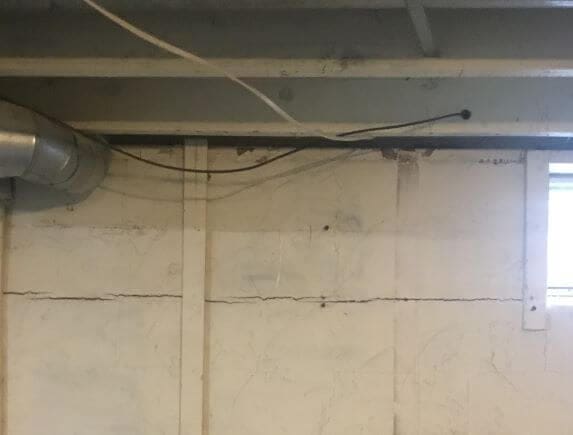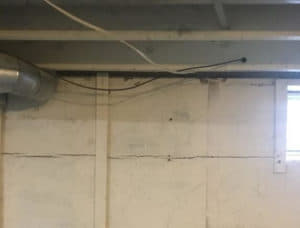DIY Home Inspection Checklist For Your Foundation

Originally posted 4/2/20; updated 7/5/21
If you own a car, I’m sure you’re familiar with routine maintenance. You don’t wait until the engine is making a horrible noise before you change the oil, right? That would be a disaster! Once your engine seizes up, your car is essentially scrap metal.
Your house also needs routine maintenance; you have to change furnace filters, clean gutters, and test smoke alarms regularly. You should also examine your home for signs of developing problems.
Your foundation is the base of your home- everything else is resting on it, depending on it to hold firm. You need to make sure that it’s healthy and strong. If left unattended, a bowing wall can collapse, water seepage will create mold that threatens your health, a sagging floor will give way and fall.
Acculevel has been repairing foundations since 1996, and we want to help homeowners catch problems early. This is when repairs are least expensive and the easiest to resolve.
If you have already noticed an area of concern, we have a free symptom checker as an additional source of information:
If your home currently seems to be in excellent shape, we’d like to help you keep it that way! Please use this checklist as a reference guide to review your home and property. We have modeled it after our own 21 Point Inspection, which we provide for customers (at $500 for 5 years.)
We recommend that you perform this check at least once per year. Certain steps like cleaning gutters or clearing out window wells should be done in both spring and fall.
Inside Your Home:
Going room by room, look at each of these items in turn:
- Notice the floors. Do they sag or slope? Are there gaps or unevenness between the floor and the baseboard? If you see any issues here, you’ll need to pay extra attention to your floor joists (see next section, item 1.1).
- Look at the walls and ceiling. Are there any cracks forming? If there are cracks- especially around doors or windows, pay extra attention to the next item.
- Test the doors & windows. Do they operate smoothly? Open and close each one; will they stay open without assistance? When closed, do they stay shut or do you have to lock them to keep them closed? Sticking windows and doors, when combined with cracks around them, usually indicate settling has occurred. This can lead to a cracked or bowing foundation, which can be a significant and expensive repair. The sooner this is addressed, the less severe the damage to your home (and wallet!).
Under Your Home in Crawl Space/Basement:
I. Begin by looking above you at the floor joists and beams.
You want to see clean healthy boards that you aren’t afraid to touch with bare hands.
- If any of them are damp, cracked, or crooked, you need a professional evaluation. Sagging floors can be repaired; if you act quickly, you can prevent more significant (and expensive!) damage.
- Discoloration can mean mildew or mold, especially if the area feels damp or humid. Smell the air near this section- we all know mold has a particular odor, and can cause serious health problems for you and your family.
- Look for any bubbling, flaking or a substance like powdery sawdust; these can indicate insect problems.
II. Check the “floor.”
This is a relative term in a crawl space, where the floor is usually dirt.
- If you have a basement, look for any cracks in the concrete. How wide are the cracks? Is there any sign that they have been (or currently are) letting in water?
- If you have a crawl space, does it have a vapor barrier in place? Look for any rips or tears.
- In either case, pay special attention to any discoloration or signs of moisture. Water getting through the floor or above the vapor barrier is bad news for your foundation.
III. Now review the walls.
- Again, you’re looking for cracks. An occasional hairline crack is common, and not an immediate cause for concern. Where Acculevel services, the cycle of freeze-thaw-freeze has an impact on homes in the midwest. Regular contraction and expansion can cause slight hairline cracks..
- But if you see wider cracks- particularly if they are uneven in width or letting water in- are a sign you have problems.
- Please note: If you find horizontal cracks in poured concrete, or stair-step cracks in block foundations, you should call a professional. If that wall is bowing or leaning inward, you need an evaluation immediately.
This photo was taken by an Acculevel project manager during a routine appointment. The long horizontal crack is clearly visible and is a sign of hydrostatic pressure (water pushing the wall inward).
The long horizontal crack is clearly visible and is a sign of hydrostatic pressure (water pushing the wall inward).
If You Have Equipment Installed:
I. Sump Pump- You should check each component for efficiency.
- Clean the sump pump, then make sure the pit is clean and free of debris.
- If your system has a battery back up, this should also be cleaned and tested. The simplest way to do this is to unplug the sump pump, and confirm the backup kicks on.
- If your sump pump does not have a battery backup, consider adding one. This is something we highly recommend; it’s a small investment that can prevent large cleanup issues later. (Acculevel can install one for you, if you’re not comfortable doing so yourself.).
- Verify that the pump is plugged in, and that the electrical outlet has power.
II. Dehumidifier
- Clean the unit and verify that it is plugged in, and that the electrical outlet has power.
- Make sure the setting is at 50% or lower. If it isn’t currently running, briefly turn it down until the unit kicks on.
- Once the unit is running, verify that the water runs smoothly through the drainage line. Are there any cracks or breaks in the line? Watch for leaks, and verify this line is routed to your sump pump pit.
- Once this is checked, make sure you restore the previous humidity setting!
Outside Your Home
I. Walk around the perimeter of your home, and review the grading of the landscape.
- Are there any signs that erosion has occurred? If there are any puddles next to the foundation, you need to regrade this area promptly.
- Check the window wells for any signs of water, and remove any leaf litter or debris that may have accumulated over the winter. (This step should also be done in the fall, for obvious reasons!)
- If you have an egress window in your basement, check that the cover is still firmly velcroed in place. Also make sure the steps built into the wall are clean. If any moisture has gotten into the well, there may be some mildew on the steps and that can make them slick.
II. Evaluate the various concrete slabs around your house- driveway, porch, patio, etc.
- Are these intact and even? Look for any signs that they are shifting or sinking. An uneven slab can collect rainwater and direct it towards your foundation. In many cases, the slab can be lifted back to position.
III. Clean your gutters, and make certain they drain down and away from your home.
- If your downspouts are clogged, or aren’t far enough from your home, rainwater will accumulate around your foundation. You may need to downspout extensions to prevent this.
- If you have a sump pump installed, you should make sure the discharge line for it is working properly, and is directed away from the house. The easiest way to do this is to pour several gallons of water into the sump pump pit, then go outside and follow the water line.
Did Your DIY Home Inspection Reveal Potential Issues?
We hope the answer is no, and that you can look forward to many happy years in your home with very few issues or concerns. But if you have seen evidence of:
- Sagging floors
- Settling foundation
- Growing mold
- Cracks in foundation
- Bowing foundation walls
- Failing equipment (sump pump or dehumidifier)
- Water leaks, high humidity, or water damage
You should find an experienced foundation company, and make an appointment. Before you sign a contract for any service, we urge you to always verify the company is reputable, insured, and accredited by the Better Business Bureau.
If you live in Indiana or the surrounding states, contact Acculevel. If you have noticed any problems and would like an evaluation, you can request a free estimate. An experienced project manager will examine the areas of concern and recommend the best course of action for you, to keep your home strong and healthy for years to come.
